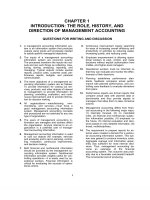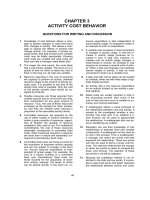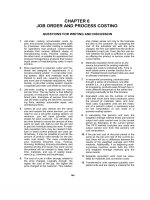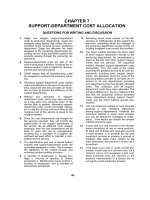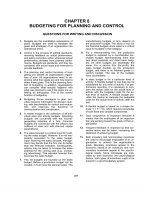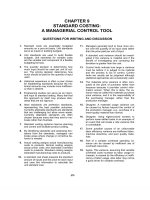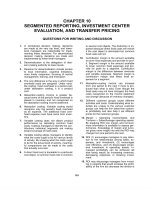Solution manual managerial accounting concept and applications by cabrera chapter 24 answer
Bạn đang xem bản rút gọn của tài liệu. Xem và tải ngay bản đầy đủ của tài liệu tại đây (129.37 KB, 12 trang )
MANAGEMENT ACCOUNTING - Solutions Manual
CHAPTER 24
ADVANCED ANALYSIS AND
APPRAISAL OF PERFORMANCE:
FINANCIAL AND NONFINANCIAL
I.
Questions
1. Return on investment (ROI) is the ratio of profit to amount invested for
the business unit.
2. The measurement issues for ROI are:
a.
The effect of accounting policies, which affect the determination of
net income.
b. Other measurement issues for income, which include the handling
of non-recurring items in the income statement, differences in the
effect of income taxes across units, differential effect of foreign
currency exchange, and the effect of cost allocation when two or
more units share a facility or cost.
c. Measuring investment: which assets to include.
d. Measuring investment: allocating the cost of shared assets.
3. The advantages of return on investment are:
a. It is intuitive and easily understood.
b. It provides a useful basis for comparison among SBUs.
c. It is widely used.
The limitations of return on investment are:
a. It has an excessive short-term focus.
b. Investment planning uses discounted cash flow analysis while
managers are evaluated on ROI.
c. It contains a disincentive for new investment by the most
profitable units.
4. The key advantage of residual income is that it deals effectively with
the limitation of ROI, that is ROI has a disincentive for the managers
of the most profitable units to make new investments. With residual
income, no matter how profitable the unit, there is still an incentive for
new profitable investment. In contrast, a key limitation is that since
residual income is not a percentage, it suffers the same problem of
24-1
Chapter 24 Advanced Analysis and Appraisal of Performance: Financial and Nonfinancial
profit SBUs in that it is not useful for comparing units of significantly
difference sizes. It favors larger units that would be expected to have
larger residual incomes, even with relatively poor performance.
Moreover, relatively small changes in the desired minimum rate of
return can dramatically affect the residual income for different size
units. And, in contrast to ROI, some managers do not find residual
income to be as intuitive and as easily understood.
5. Economic value added (EVA) is a business unit’s income after taxes
and after deducting the cost of capital. The idea is very similar to what
we have explained as residual income. The objectives of the measures
are the same – to effectively motivate investment SBU managers and to
properly measure their performance. In contrast to residual income,
EVA uses the firm’s cost of capital instead of a desired rate of return.
For many firms the desired rate of return and the cost of capital will be
nearly the same, with small differences due to adjustments for risk and
for strategic goals such as the desired growth rate for the firm. Also,
while residual income is intended to deal with the undesirable effects
of ROI, EVA is used to focus managers’ attention on creating value for
shareholders, by earning profits greater than the firm’s cost of capital.
6. Examples of financial and nonfinancial measures of performance are:
Financial:
Nonfinancial:
ROI, residual income, and return on sales.
Manufacturing lead time, on-time performance, number
of new product launches, and number of new patents
filed.
7. The six steps in designing an accounting-based performance measure
are:
a.
Choose performance measures that align with top management’s
financial goal(s).
b. Choose the time horizon of each performance measure in Step 1.
c. Choose a definition of the components in each performance
measure in Step 1.
d. Choose a measurement alternative for each performance measure in
Step 1.
e. Choose a target level of performance.
f. Choose the timing of feedback.
8. Yes. Residual income (RI) is not identical to return on investment
(ROI). ROI is a percentage with investment as the denominator of the
computation. RI is an absolute amount in which investment is used to
calculate an imputed interest charge.
24-2
Advanced Analysis and Appraisal of Performance: Financial and Nonfinancial Chapter 24
9. Economic value added (EVA) is a specific type of residual income
measure that is calculated as follows:
Economic
value added =
(EVA)
After tax
operating
income
Weighted
Average Cost x
of Capital
Total Assets
minus Current
Liabilities
10. Definitions of investment used in practice when computing ROI are:
a. Total assets available.
b. Total assets employed.
c. Working capital (current assets minus current liabilities) plus other
assets.
d. Equity.
11. Present value is the asset measure based on DCF estimates. Current
cost is the cost of purchasing an asset today identical to the one
currently held if identical assets can currently be purchased; it is the
cost of purchasing the services provided by that asset if identical assets
cannot currently be purchased. Historical-cost-based measures of ROI
compute the asset base as the original purchase cost of an asset minus
any accumulated depreciation.
Some commentators argue that present value is future-oriented and
current cost is oriented to current prices, while historical cost is pastoriented.
12. Special problems arise when evaluating the performance of divisions in
multinational companies because
a.
The economic, legal, political, social, and cultural environments
differ significantly across countries.
b. Governments in some countries may impose controls and limit
selling prices of products.
c. Availability of materials and skilled labor, as well as costs of
materials, labor, and infrastructure may differ significantly across
countries.
d. Divisions operating in different countries keep score of their
performance in different currencies.
13. a. Consider each activity and the organization itself from the
customer’s perspective,
b. Evaluate each activity using customer-validated measures of
performance,
c. Consider all facets of activity performance that affect customers
and are comprehensive, and
24-3
Chapter 24 Advanced Analysis and Appraisal of Performance: Financial and Nonfinancial
d. Provide feedback to help organization members identify problems
and opportunities for improvement.
II. Exercises
Exercise 1 (ROI and Residual Income)
Requirement 1
A quick inspection of the data shows mortgage loans with a higher ROI to
be more successful. But see requirement 2 below.
Requirement 2
Total Assets
Operating Income
Return on Investment
Residual Income:
(a) * at 11%
(b) ** at 15%
(c) *** at 17%
Division A
(Mortgage Loans)
P2,000
400
25%
P180
100
60
Division B
(Consumer Loans)
P10,000
1,500
15%
P400
0
(200)
*
P400 – (P2,000 x 0.11) = P180 P1,500 – (P10,000 x 0.11) = P 400
** P400 – (P2,000 x 0.15) = P100 P1,500 – (P10,000 x 0.15) = P 0
*** P400 – (P2,000 x 0.17) = P 60 P1,500 – (P10,000 x 0.17) = P(200)
There is no simple answer to which is more successful in terms of residual
income. Division B is more successful at low rates, while A is more
successful at high rates. This reflects an important limitation of residual
income; larger divisions (Division B in this case) are favored when the
desired return used to determine residual income is relatively low.
Exercise 2 (Return on Investment; Comparisons of Three Companies)
Sales
Income
Investment (assets)
Return on sales
Asset turnover
Companies in the Same Industry
A
B
C
P1,500,000
P 750,000
P3,750,000
200,000
75,000
18,750
500,000
7,500,000
2,500,000
13%
10%
0.5%
3
0.1
1.5
24-4
Advanced Analysis and Appraisal of Performance: Financial and Nonfinancial Chapter 24
Return on investment
40%
1%
0.75%
Exercise 3 (ROI, RI, ROS, Management Incentives)
Requirement 1
If Magic Industries uses return on investment to measure the Jump-Start
Division’s (JSD’s) performance, Tan may be reluctant to invest in the new
plant because, as shown below, return on investment for the plant of 19.2%
is lower than JSD’s current ROI of 24%.
Operating income for new plant
New investment
Return on investment for new plant
P480,000
P2,500,000
19.2%
Investing in the new plant would lower JSD’s ROI and, hence, limit Tan’s
bonus.
Requirement 2
The residual income computation for the new plant is as follows:
Residual income = Income- (Imputed interest x Investment)
Investment
Operating income for new plant
Charge for funds
(Investment, P2,500,000 x 15%)
Residual income
P2,500,000
P 480,000
375,000
P 105,000
Investing in the new plant would add P105,000 to JSD’s residual income.
Consequently, if Magic Industries could be persuaded to use residual
income to measure performance, Tan would be more willing to invest in the
new plant.
Requirement 3
Return on Sales (ROS) =
Operating income
Sales
480,000
2,400,000
=
20%
If Magic Industries uses ROS to determine Tan’s bonus, Tan will be more
willing to invest in the new plant because ROS for the new plant of 20%
exceeds the current ROS of 19%.
24-5
=
Chapter 24 Advanced Analysis and Appraisal of Performance: Financial and Nonfinancial
The advantages of using ROS are (a) that it is simpler to calculate and (b)
that it avoids the negative short-run effects of ROI measures that may
induce Tan to not make the investment in the new plant. Tan may favor
ROS because she believes that eventually increases in ROS will increase
ROI and RI.
The main disadvantage of using ROS is that it ignores the amount of
investment needed to earn a return. For example, ROS may be high but not
high enough to justify the level of investment needed to earn the required
return on an investment.
III. Problems
Problem 1 (RI, EVA)
Requirement 1
Total assets
Current liabilities
Investment
(Total
assets
–
current
liabilities)
Required
return
(12%
x
Investment)
Operating income before tax
Residual income
(Operating income before tax –
required return)
Truck Rental
Division
P650,000
120,000
Transportation
Division
P950,000
200,000
530,000
750,000
63,600
90,000
75,000
160,000
11,400
70,000
Requirement 2
After-tax cost of debt financing = (1 – 0.4) x 10% = 6%
After-tax cost of equity financing = 15%
Weighted average =
cost of capital
P900,000 x 6% + 600,000 x 15%
P900,000 + 600,000
Required return for EVA
9.6% x Investment
(9.6% x P530,000; 9.6% x
P750,000)
P50,880
24-6
=
9.6%
P72,000
Advanced Analysis and Appraisal of Performance: Financial and Nonfinancial Chapter 24
Operating income after tax
0.6 x operating income before tax
45,000
96,000
EVA (Operating income after tax –
required return)
(5,880)
24,000
Requirement 3
Both the residual income and the EVA calculations indicate that the
Transportation Division is performing better than the Truck Rental
Division. The Transportation Division has a higher residual income
(P70,000 versus P11,400) and a higher EVA [P24,000 versus P(5,880)].
The negative EVA for the Truck Rental Division indicates that, on an aftertax basis, the division is destroying value – the after-tax economic return
from the Truck Rental Division’s assets is less than the required return. If
EVA continues to be negative, Lighthouse may have to consider shutting
down the Truck Rental Division.
Problem 2 (ROI, RI, Measurement of Assets)
The method for computing profitability preferred by each manager follows:
Manager of
S
P
F
Method Chosen
Residual income based on net book value
Residual income based on gross book value
ROI based on either gross or net book value
Supporting Calculations:
Division
S
P
F
Return on Investment Calculations
Operating Income
Operating Income
Gross Book Value
Net Book Value*
P94,700 P800,000 = 11.84% (3) P94,700 P370,000 = 25.59% (3)
P91,700 P760,000 = 12.07% (2) P91,700 P350,000 = 26.20% (2)
P61,400 P500,000 = 12.28% (1) P61,400 P220,000 = 27.91% (1)
Division
S
P
F
Residual Income Calculations
Operating Income – 10% Gross BV Operating Income – 10% Net BV*
P94,700 – P80,000 = P14,700 (2) P94,700 – P37,000 = P57,700 (1)
P91,700 – P76,000 = P15,700 (1) P91,700 – P35,000 = P56,700 (2)
P61,400 – P50,000 = P11,400 (3) P61,400 – P22,000 = P39,400 (3)
* Net book value is gross book value minus accumulated depreciation.
24-7
Chapter 24 Advanced Analysis and Appraisal of Performance: Financial and Nonfinancial
The biggest weakness of ROI is the tendency to reject projects that will
lower historical ROI even though the prospective ROI exceeds the required
ROI. RI achieves goal congruence because subunits will make investments
as long as they earn a rate in excess of the required return for investments.
The biggest weakness of residual income is it favors larger divisions in
ranking performance. The greater the amount of the investment (the size of
the division), the more likely that larger divisions will be favored assuming
that income grows proportionately.
Problem 3 (Multinational Performance Measurement, ROI, RI)
Requirement 1
(a)
Phil. Division’s ROI in 2005 =
Operating income
Total assets
=
Operating income
P8,000,000
=
15%
Hence, operating income = 15% x P8,000,000 = P1,200,000.
(b)
Swedish Division’s ROI in 2005 in kronas =
9,180,000 kronas
60,000,000 kronas
=
15.3%
Requirement 2
Convert total assets into pesos at December 31, 2004 exchange rate, the
rate prevailing when the assets were acquired (8 kronas = P1)
24,000,000 kronas =
60,000,000 kronas
=
8 kronas per peso
P7,500,000
Convert operating income into pesos at the average exchange rate
prevailing when during 2005 when operating income was earned equal to
9,180,000 kronas
8.5 kronas per peso = P1,080,000
Comparable ROI for Swedish Division =
P1,080,000
P7,500,000
=
14.4%
The Swedish Division’s ROI calculated in kronas is helped by the inflation
that occurs in Sweden in 2005. Inflation boosts the division’s operating
24-8
Advanced Analysis and Appraisal of Performance: Financial and Nonfinancial Chapter 24
income. Since the assets are acquired at the start of the year on 1-1-2005,
the asset values are not increased by the inflation that occurs during the
year. The net effect of inflation on ROI calculated in kronas is to use an
inflated value for the numerator relative to the denominator. Adjusting for
inflationary and currency differences negates the effects of any differences
in inflation rates between the two countries on the calculation of ROI.
After these adjustments, the Phil. Division shows a higher ROI than the
Swedish Division.
Requirement 3
Phil. Division’s RI in 2005 =
=
P1,200,000 – 12% x P8,000,000
P1,200,000 – P960,000 = P240,000
Swedish Division’s RI in 2005 (in Phil. pesos) is
P1,080,000 – 12% x P7,500,000 = P1,080,000 – P900,000 = P180,000.
The Phil. Division’s RI also exceeds the Swedish Division’s RI in 2005 by
P60,000 (P240,000 – P180,000).
Problem 4 (ROI Performance Measures Based on Historical Cost and
Current Cost)
Requirement 1
ROI using historical cost measures:
P130,000
P340,000
=
38.24%
Visayas Division
P220,000
P1,150,000
=
19.13%
Mindanao Division
P380,000
P1,620,000
=
23.46%
Luzon Division
The Luzon Division appears to be considerably more efficient than the
Visayas and Mindanao Divisions.
Requirement 2
24-9
Chapter 24 Advanced Analysis and Appraisal of Performance: Financial and Nonfinancial
The gross book values (i.e., the original costs of the plants) under historical
cost are calculated as the useful life of each plant (12) x the annual
depreciation:
Luzon
Visayas
Mindanao
12 x P 70,000
12 x P100,000
12 x P120,000
=
=
=
P 840,000
P1,200,000
P1,440,000
Step 1: Restate long-term assets from gross book value at historical costs
to gross book value at current cost as of the end of 2005.
Gross book value
of long-term assets
at historical cost
x
Construction cost index in 2005
Construction cost index in year of construction
Luzon
P 840,000 x (170 100) = P1,428,000
Visayas
P1,200,000 x (170 136) = P1,500,000
Mindanao
P1,440,000 x (170 160) = P1,530,000
Step 2: Derive net book value of long-term assets at current cost as of the
end of 2005. (Estimated useful life of each plant is 12 years).
Gross book value
of long-term assets
at current cost at
the end of 2005
Luzon
Visayas
Mindanao
x
Estimated useful life remaining
Estimated total useful life
P1,428,000 x (2 12)
P1,500,000 x (9 12)
P1,530,000 x (11 12)
=
=
=
P 238,000
P1,125,000
P1,402,500
Step 3: Compute current cost of total assets at the end of 2005. (Assume
current assets of each plant are expressed in 2005 pesos.)
Current assets at the end
Net book value of long-term assets at
+ current cost at the end of 2005 (Step 2)
of 2005 (given)
Luzon
P200,000 + P238,000
= P 438,000
Visayas
P250,000 + P1,125,000
= P1,375,000
Mindanao
P300,000 + P1,402,500
= P1,702,500
Step 4: Compute current-cost depreciation expense in 2005 pesos.
Gross book value of long-term assets at current cost at the end of 2005
(from Step 1) x (1 12)
24-10
Advanced Analysis and Appraisal of Performance: Financial and Nonfinancial Chapter 24
P1,428,000 x (1 12)
P1,500,000 x (1 12)
P1,530,000 x (1 12)
Luzon
Visayas
Mindanao
=
=
=
P119,000
P125,000
P127,500
Step 5: Compute 2005 operating income using 2005 current-cost
depreciation.
Historical-cost
operating income
Luzon
Visayas
Mindanao
–
Current-cost depreciation
in 2005 pesos (Step 4) –
P130,000 – (P119,000 – P70,000)
P220,000 – (P125,000 – P100,000)
P380,000 – (P127,500 – P120,000)
Historical-cost
depreciation
=
=
=
P 81,000
P195,000
P372,500
Step 6: Compute ROI using current-cost estimate for long-term assets and
depreciation.
Operating income for 2005 using 2005 current cost depreciation (Step 5)
Current cost of total assets at the end of 2005 (Step 3)
Luzon
Visayas
Mindanao
Luzon
Visayas
Mindanao
P 81,000 P 438,000
P195,000 P1,375,000
P372,500 P1,702,500
ROI: Historical Cost
38.24%
19.13%
23.46%
=
=
=
18.49%
14.18%
21.88%
ROI: Current Cost
18.49%
14.18%
21.88%
Use of current cost results in the Mindanao Division appearing to be the
most efficient. The Luzon ROI is reduced substantially when the ten-yearold plant is restated for the 70% increase in construction costs over the
1995 to 2005 period.
Requirement 3
Use of current costs increases the comparability of ROI measures across
divisions’ operating plants built at different construction cost price levels.
Use of current cost also will increase the willingness of managers,
evaluated on the basis of ROI, to move from divisions with assets
24-11
Chapter 24 Advanced Analysis and Appraisal of Performance: Financial and Nonfinancial
purchased many years ago to division with assets purchased in recent
years.
IV. Multiple Choice Questions
1.
2.
3.
4.
5.
6.
7.
8.
9.
10.
A
B
C
C
D
B
A
C
B
A
11.
12.
13.
14.
15.
16.
17.
18.
19.
20.
B
D
C
A
C
C
A
C
B
A
21.
22.
23.
24.
25.
26.
27.
28.
29.
30.
24-12
C
D
C
A
C
D
A
C
D
D
31.
32.
33.
34.
35.
36.
37.
A
A
B
A
C
B
D
